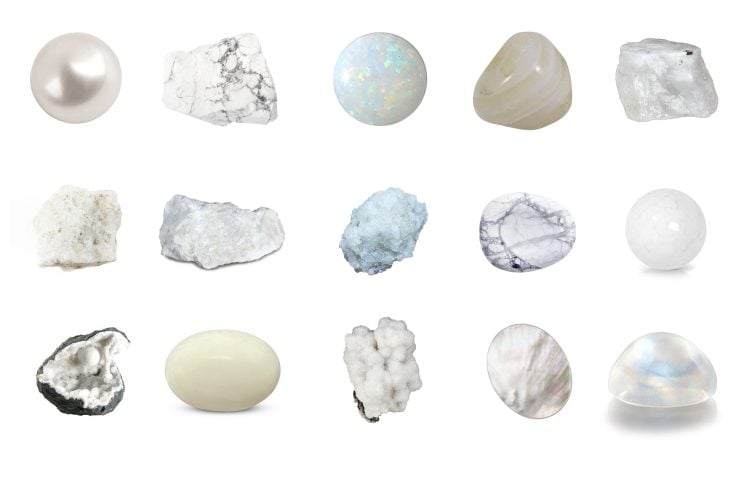Last Updated on April 15, 2024 by Carla Jonas
They’re a part of our beloved jewelry, they’re an important part in crystal healing rituals, they create beautiful finishes and décor in our homes – and they’ve been around forever. White gemstones are the epitome of tranquility, protection and hope, as well as a cherished symbol of purty and inspiration.
From timeless classics to rare and unique finds, we explore the diversity of white gemstones, delving into their individual characteristics, symbolism, and the allure that has captivated enthusiasts for centuries. Discover the beauty and significance behind each mesmerizing gem in our comprehensive guide on no less than 39 Types of White Gemstones.
White Gemstones – Frequently Asked Questions
Pearls are the most popular gems with a white coloring. Although pearls can come in a wide range of colors, white is the most predominant color, both in freshwater and saltwater pearls (Akoya, South Sea and Tahitian). Moonstone, white opal, quartz and onyx are other highly popular white gems.
Among white gemstones, the rarest is considered to be grandidierite, although this gem is not particularly valued for its white tint, but rather for its striking bluish hue. Its scarcity, combined with its mesmerizing appearance, contributes to grandidierite’s status as one of the most coveted and elusive white gemstones in the world of gemology.
Each color holds special significance when it comes to gemstones. For example, pink gemstones evoke love, compassion and kindness, while black gemstones represent protection and higher purpose. White gemstones are usually associated with the concepts of purity, calmness, healing, protection, unity, hope and inspiration.
The June birthstones pearls and moonstone are generally white, as well as opal, one of the October birthstones.
Each gemstone possesses a distinctive chemical and atomic structure. Diamonds consist of carbon, rubies and sapphires are formed from aluminum chloride, and so forth. This unique composition, coupled with impurities, results in the absorption of diverse wavelengths of light, contributing to the array of colors observed in gemstones.
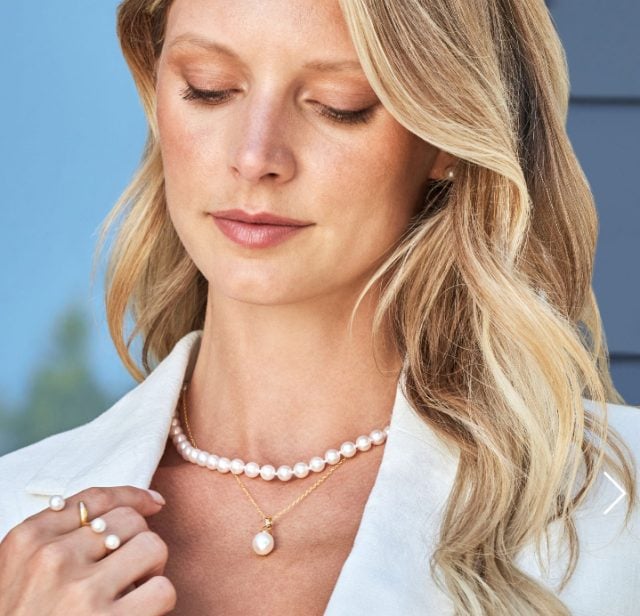
GEM SPOTLIGHT
Discover the beauty of the ultimate white gemstone: the pearl. White pearls come in a remarkable array of shapes, sizes and overtones, from crisp whites to champagne, ivory and rosy hues. Have your pick from our extensive collection of White Pearls, including premium pearl necklaces, modern types of earrings, pearl bracelets, rings and pearl sets.
39 Types of White Gemstones
Pearl
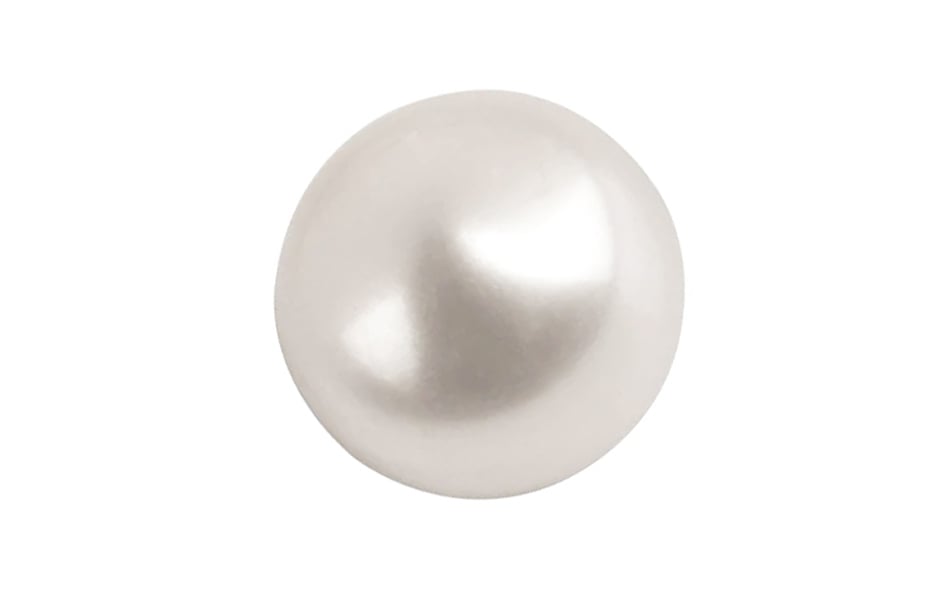
Characteristics: Pearls are gems of organic origin, as they form inside different species of freshwater and saltwater mollusks. Pearls derive their value from a combination of factors. Pearl luster, the reflective quality on the surface, plays a pivotal role, with high-quality pearls exhibiting a radiant glow. Size (round, elongated, baroque, keshi or button), shape, color, surface quality and origin further contribute to their appeal. The interplay of these factors determines the unique and cherished value of each pearl.
Colors: Their predominant color is white, with various overtones: rose, ivory, champagne and even green. Other popular pearl colors include pink, peach, golden and darker shades ranging from silver to copper and peacock (Tahitian pearls).
Mohs Hardness Score: 2.5 – 4.5
Quartz
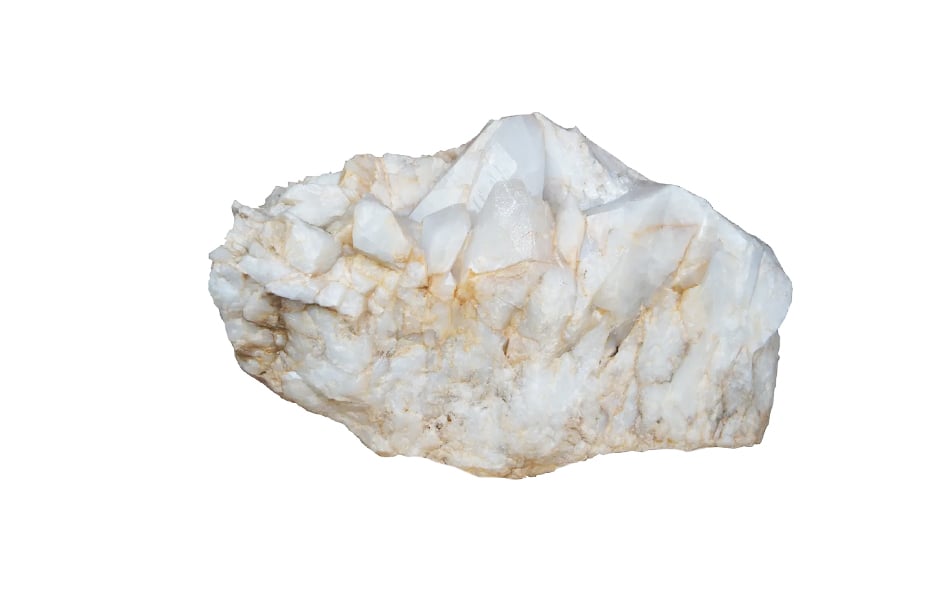
Characteristics: White quartz, a variety of crystalline silicon dioxide, showcases a spectrum of shades, from milky white to icy colors. Its clarity ranges from transparent to opaque. Often featuring intricate patterns like dendritic or smoky inclusions, white Quartz presents aesthetic diversity. Its most popular hue is light grey, a shade predominantly used in interior design. Abundant in nature, this mineral holds geological significance and finds applications in jewelry, interiors, decor, and spiritual practices due to its unique characteristics.
Colors: An impressive range of colors, including clear and milky-white. Smoky quartz features gray to brown hues, while rose quartz is pink. Purple quartz is the most valuable and commonly known as amethyst. Other notable variations include citrine (yellow), aventurine (green), tiger’s eye (brown) and carnelian (orange-red).
Moonstone
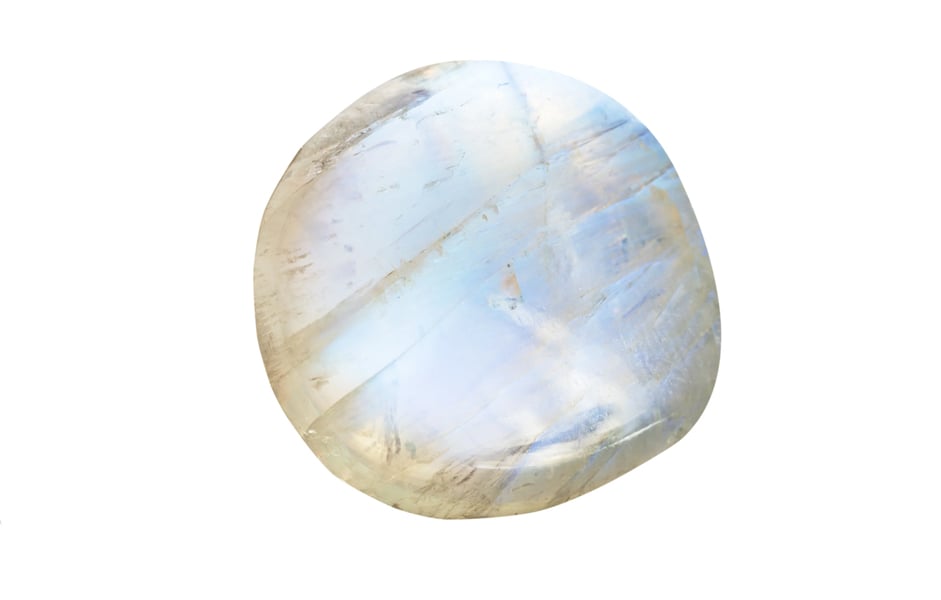
Characteristics: Moonstone is a feldspar mineral that displays an iridescent play of light known as adularescence, caused by internal reflections. The gemstone typically appears milky or translucent with a bluish or silvery sheen. While colorless moonstones are prized, they can also be found in shades like peach, green, and gray. Renowned for its metaphysical properties, moonstone is associated with emotional balance and intuition. These white gemstones are often used in jewelry, revered for their unique appearance rather than traditional brilliance.
Colors: White, iridescent blue-green, silver.
Mohs Hardness Score: 6 – 6.5
Agate
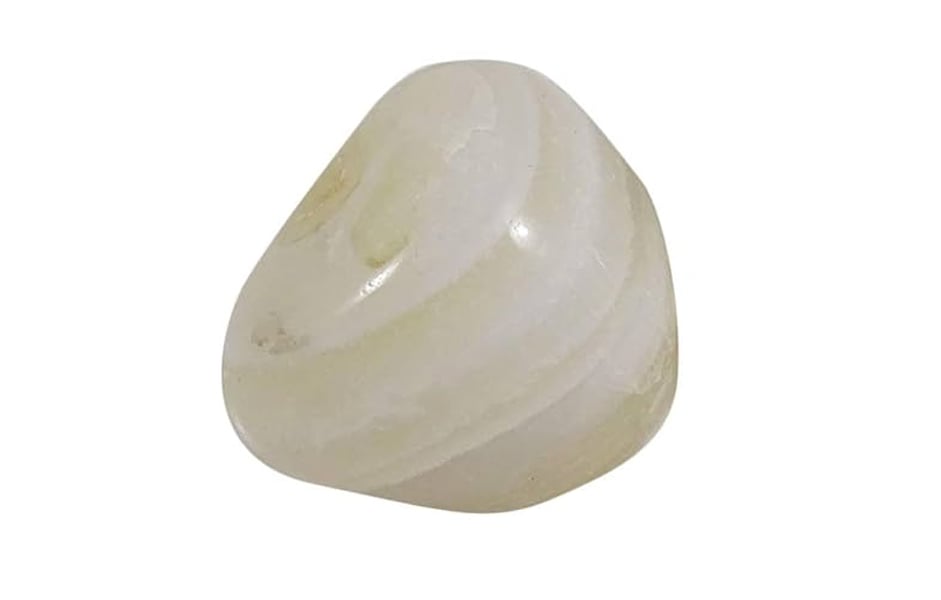
Characteristics: Agate is a microcrystalline variety of Quartz and displays a translucent, often milky appearance. Geologically, agate forms within cavities of volcanic or metamorphic rocks. Historically, agate has been used for a wide range of ornamental purposes, carved into intricate designs or used in jewelry.
Colors: Agate comes in a spectrum of shades, including white, grey and brown – and rarely in green and blue. The colors found in agate are the result of tiny crystals of iron and manganese oxide minerals.
Mohs Hardness Score: 7
Grandidierite
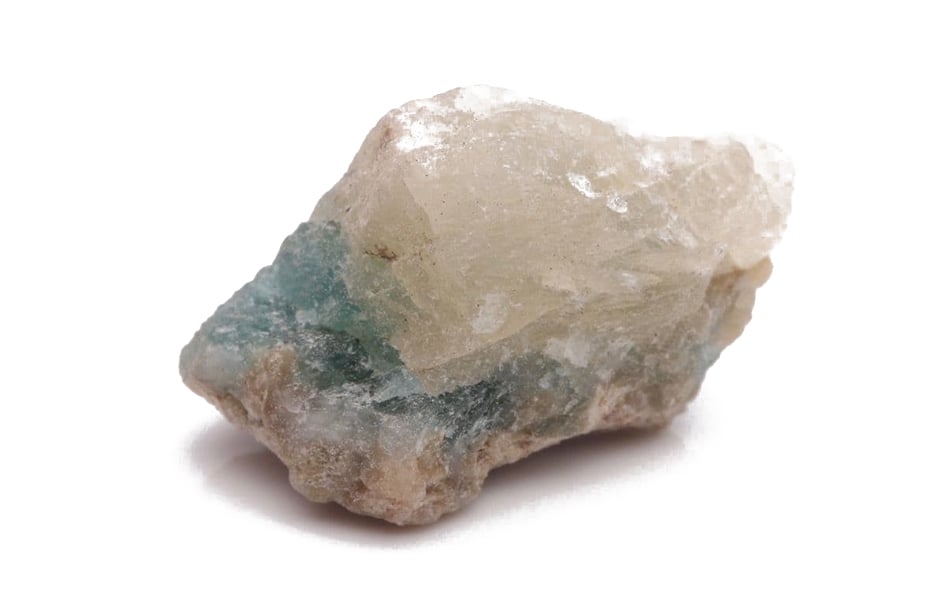
Characteristics: Grandidierite is an extremely rare mineral, famous for its piercing blue-green hues. It consists of magnesium, aluminum and a trace of iron. Grandidierite exhibits strong pleochroism, displaying different colors when viewed from distinct angles. Discovered in Madagascar in 1902, it remains one of the scarcest gemstones globally.
Colors: It has a transparent to translucent nature, showcasing a vivid spectrum ranging from sea-blue to emerald-green. Less valuable specimens come in less striking shades, such as white or grey.
Mohs Hardness Score: 7.5
Scolecite
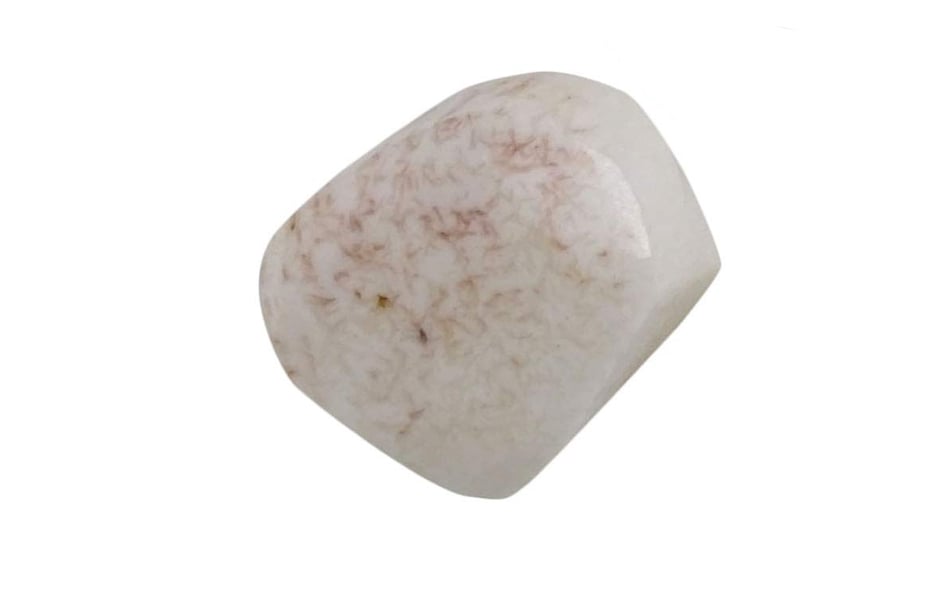
Characteristics: Scolecite is a tectosilicate mineral that is part of the zeolite group. Its luster varies from vitreous to silky. This mineral is transparent to translucent and exhibits perfect cleavage. These white gemstones are mostly found in India and Iceland. They are a favored choice in mineral collections due to their unique appearance. Its name comes from the Greek word ‘skolex’, meaning ‘worm’ because under a flame, scolecite actually takes the appearance of one, curling up like a worm.
Colors: It is typically colorless or white and features delicate, needle-like crystals that create intricate sprays or radiating clusters.
Mohs Hardness Score: 5 – 5.5
Opal

Characteristics: Opal, a hydrated amorphous form of silica, is valued for its interesting play-of-color, a phenomenon resulting from light diffraction within its microstructure. Its name comes from the Sanskrit ‘upala’ – which means ‘precious stone’, as well as from the Latin ‘opalus’ which means ‘seeing a color change’.
Colors: Opals can exhibit a kaleidoscopic range of colors, including iridescent bits of red, blue, green, and purple. Their main body color also comes in a diverse range, from white and milky blue to black.
Mohs Hardness Score: 5.5 – 6.5
Rainbow Moonstone
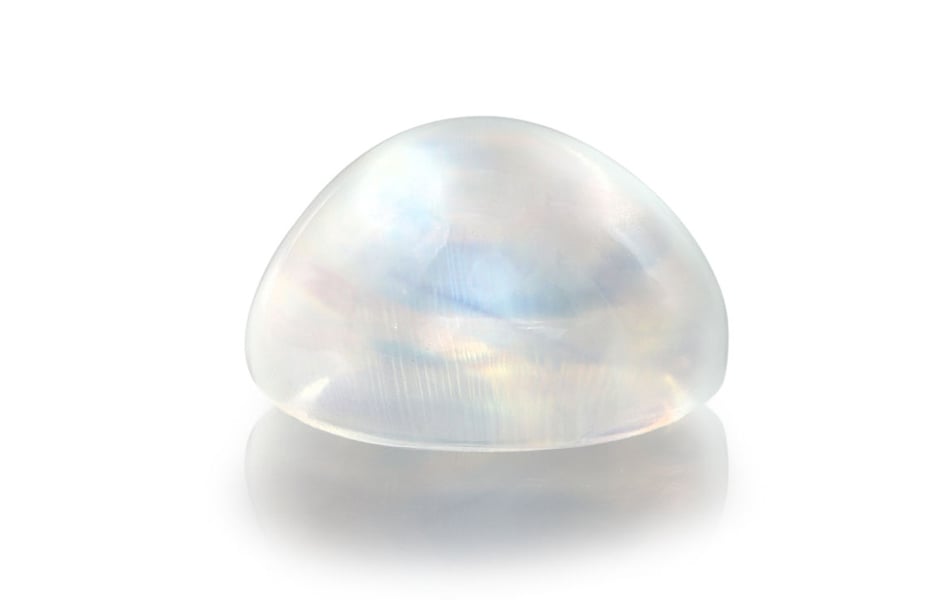
Characteristics: Rainbow Moonstone is a type of orthoclase that displays a pearl-like adularescence, featuring a play-of-color in iridescent hues that resemble a rainbow in the sky. This white crystal has a semi-translucent appearance that adds to its appeal. It is found abundantly in India and Sri Lanka and predominantly cut into cabochons to display its unique optical properties.
Colors: The gem is usually white or colorless, with a distinct blue overtone.
Mohs Hardness Score: 6 – 6.5
Okenite
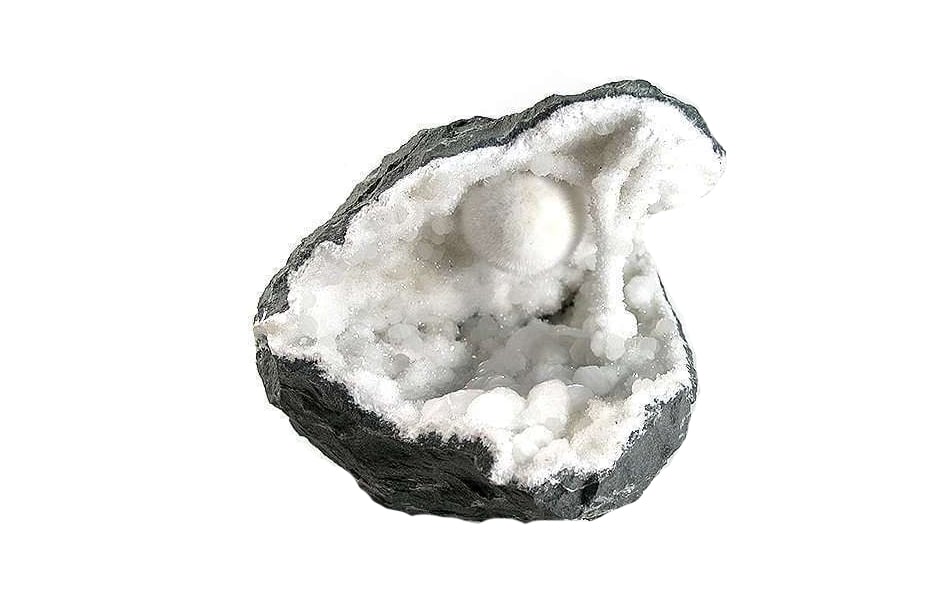
Characteristics: Okenite, part of the zeolite minerals family, typically features a pearly luster. It presents fine, snowflake-like crystals and it is usually found as small white ‘cotton ball’ formations within basalt geodes. These formations are actually clusters of straight white crystals that are bendable and fragile. It often has a fuzzy appearance and presents a translucent structure.
Colors: White, colorless or off-white.
Mohs Hardness Score: 4.5 – 5

JEWELRY SPOTLIGHT
A white gemstone that speaks a thousand words. Innocence, hope, love and timeless charm, evoking the beauty of the seas: pearls are the epitome of white gemstones and our collection of elegant Pearl Earrings is a testament to that. Choose your dream pair of studs, hoop, dangle or drop earrings and complete your pearlcore collection with a timeless piece.
Dendritic Opal
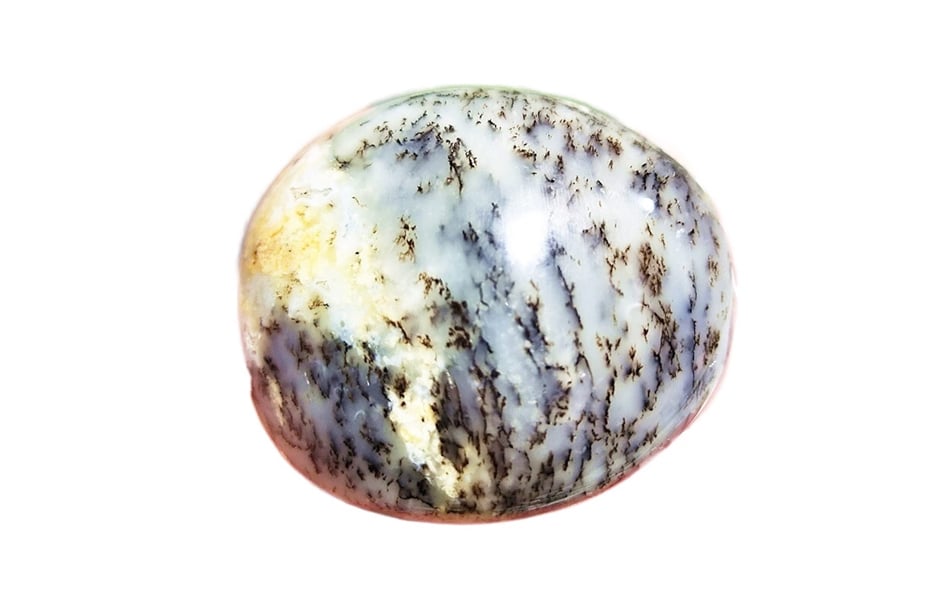
Characteristics: Dendritic opal is commonly known as merlinite or psilomelane. This type of opal presents a distinctive feature: the presence of dendritic or tree-like inclusions that show up as fern-like patterns in its structure. These are formed by mineral oxides within the Opal and are usually present in dark hues like grey or black. Due to this feature, the gems are cut as cabochons, to display the unique botanical patterns in contrasting colors.
Colors: Milky-white base with black or brown patterns.
Mohs Hardness Score: 5.5 – 6
Albite
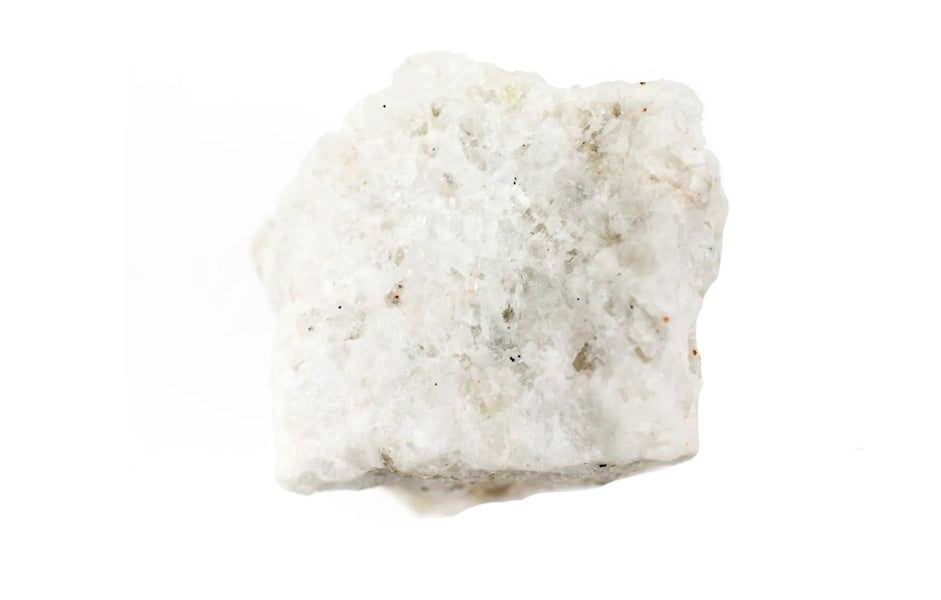
Characteristics: Albite is part of the feldspar group and it often comes with a vitreous to pearly luster. Albite’s name comes from the Latin word ‘albus’, meaning white. It is an essential part of many igneous rocks, such as granite and diorite and it forms at low temperatures. It is widely used in the ceramics and glass industry, as well as in the production of abrasives and refractory items.
Colors: It typically appears as white, gray, or colorless, and it often comes with a vitreous to pearly luster. Rare variations include yellow, pink, green, or black.
Mohs Hardness Score: 6 – 6.5
Anhydrite
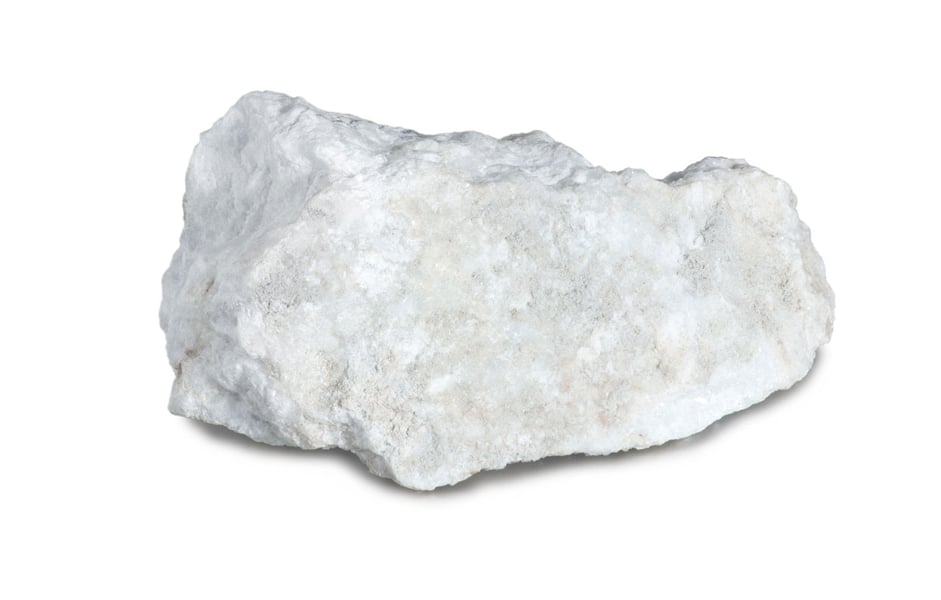
Characteristics: Anhydrite is a mineral composed of calcium sulfate, and it is a member of the sulfate mineral group. It is found in sedimentary deposits, often forming in evaporite environments where water is scarce. It has many industrial uses, mostly being utilized in the production of sulfuric acid and as a component in cement.
Colors: Anhydrite is usually colorless or white, but it can also appear in various light shades, including blue, violet, pink, gray, or brown.
Mohs Hardness Score: 3.5
Onyx
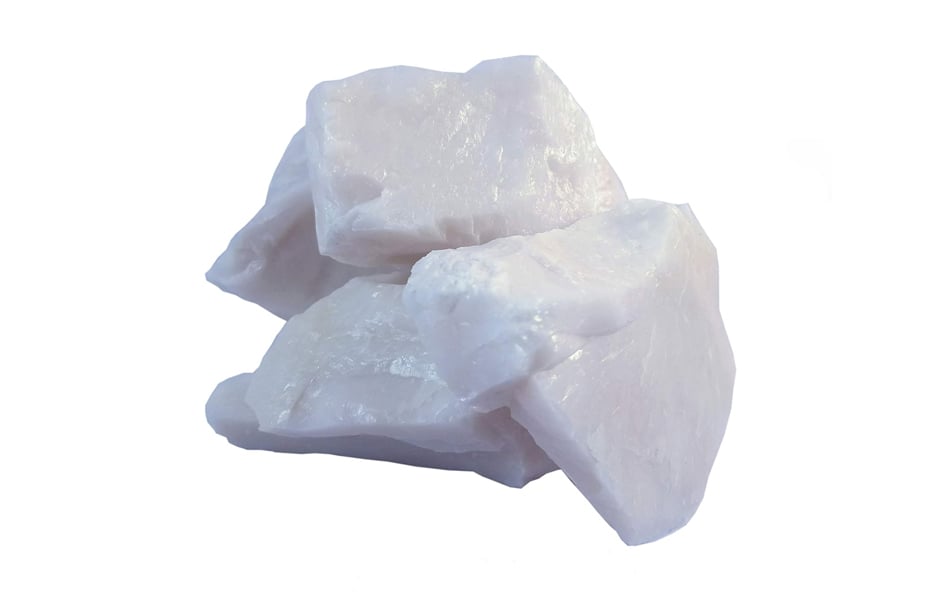
Characteristics: Onyx is a cryptocrystalline type of quartz that presents a wide range of colors, with white onyx being a standout variant. Its appearance is translucent and milky-white. Composed of fine-grained silica minerals, this metamorphic rock possesses a distinctive vitreous luster. Widely used in sculpture and jewelry since ancient times, white onyx is a durable material, scoring 7 on the Mohs scale.
Colors: Black or dark brown (most common), green, red, yellow, blue and white gemstones are all common.
Mohs Hardness Score: 7
Ivory
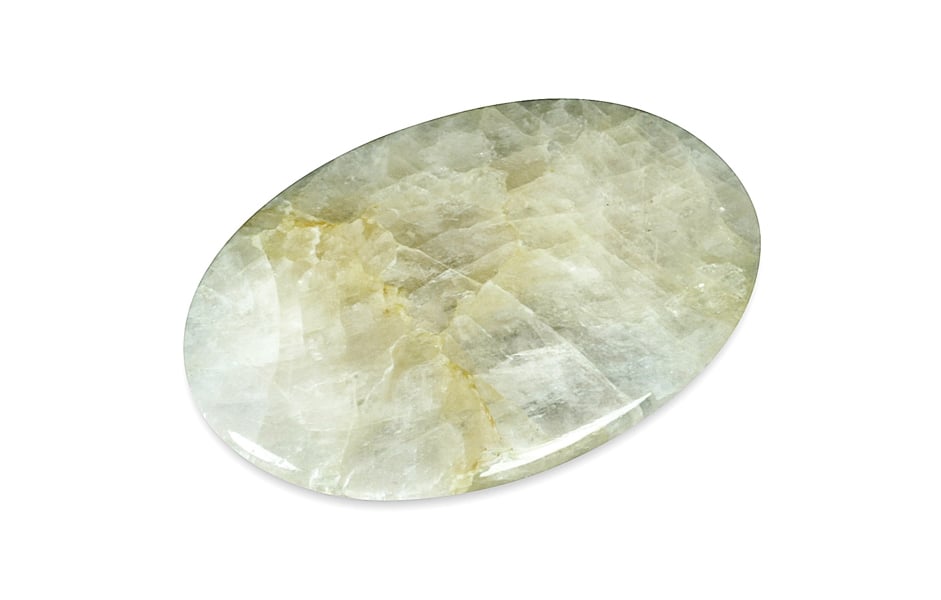
Characteristics: Ivory is the dense, hard and creamy-white material derived from the tusks and teeth of animals, typically elephants, walruses, and narwhals. Ivory has been prized for its aesthetic qualities and workability, making it a sought-after material for carving, art, and ornamentation. While historically valued for its durability and smooth texture, the trade in ivory has been widely criticized due to concerns about poaching, illegal trade, and its impact on endangered species.
Colors: Creamy white, ivory, yellow or brown (due to age).
Mohs Hardness Score: 2.7 – 3.5
Satin Spar
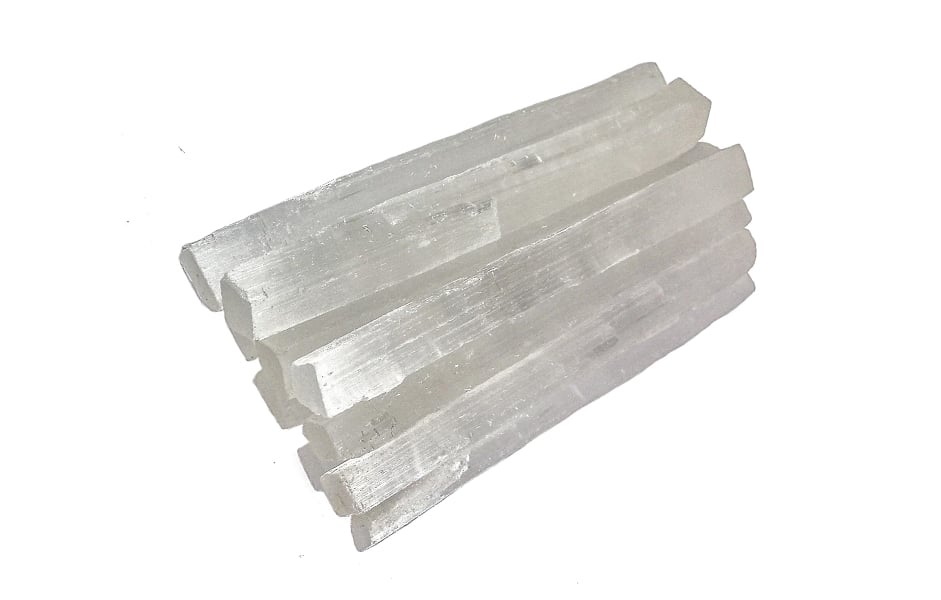
Characteristics: Satin Spar is a variety of the mineral gypsum, which consists of calcium sulfate dihydrate. It presents a fibrous or silky appearance, which gives it a sheen resembling satin fabric, hence its name. This fibrous structure can create a chatoyant effect, causing the mineral to exhibit a play of light similar to satin. Satin Spar is often used synonymously with the term “selenite,” although selenite technically refers to a crystalline form of gypsum. Satin Spar is commonly found in gypsum deposits and is frequently used for decorative purposes, such as in the creation of ornamental carvings and sculptures.
Colors: The base color is generally white, but it can sometimes present in light colors due to impurities.
Mohs Hardness Score: 2
Selenite
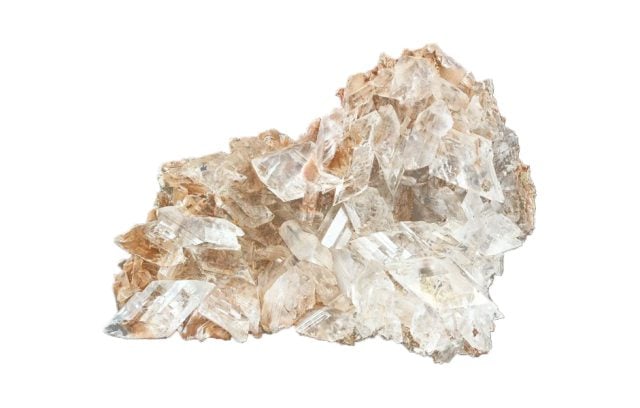
Characteristics: Selenite is a crystalline variety of the mineral gypsum, composed of calcium sulfate dihydrate. It is characterized by its transparent to translucent appearance, with its crystals featuring glass-like luster. The name ‘selenite’ comes from the Greek ‘selene’, which means moon, due to this white gem’s association with the astral body in terms of appearance and milky radiance.
Colors: Its color ranges from colorless to white, although some specimens may exhibit a slight tint.
Mohs Hardness Score: 2
Smithsonite
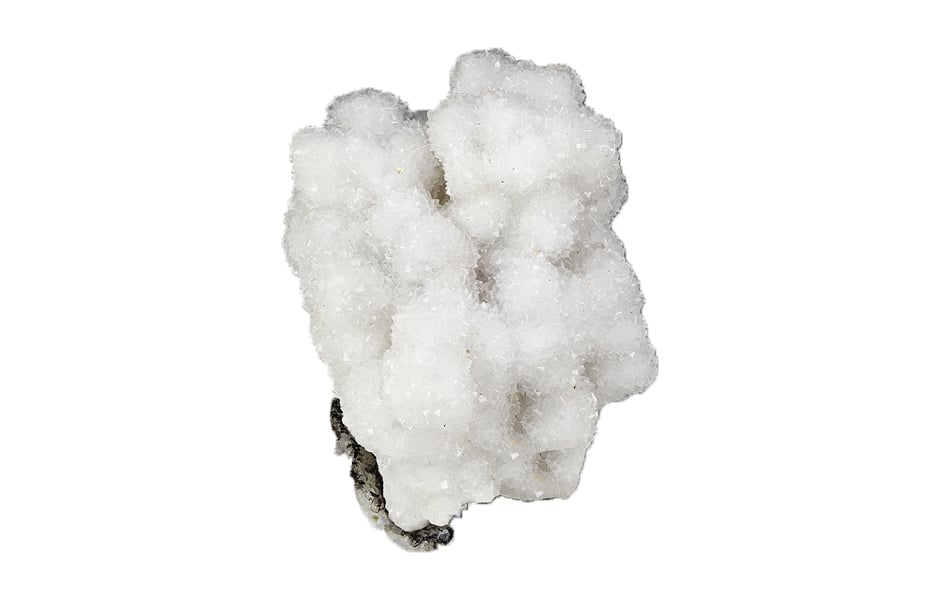
Characteristics: Smithsonite is a mineral which often presents a luster that ranges between vitreous to pearly. Due to its attractive colors and relative rarity (only found in zinc-rich environments), smithsonite is sometimes used as a collector’s mineral and can be fashioned into cabochons or used in jewelry.
Colors: A great color range, from white to yellow, brown, orange, purple, green and blue.
Mohs Hardness Score: 4.4 – 4.5
Chalcedony
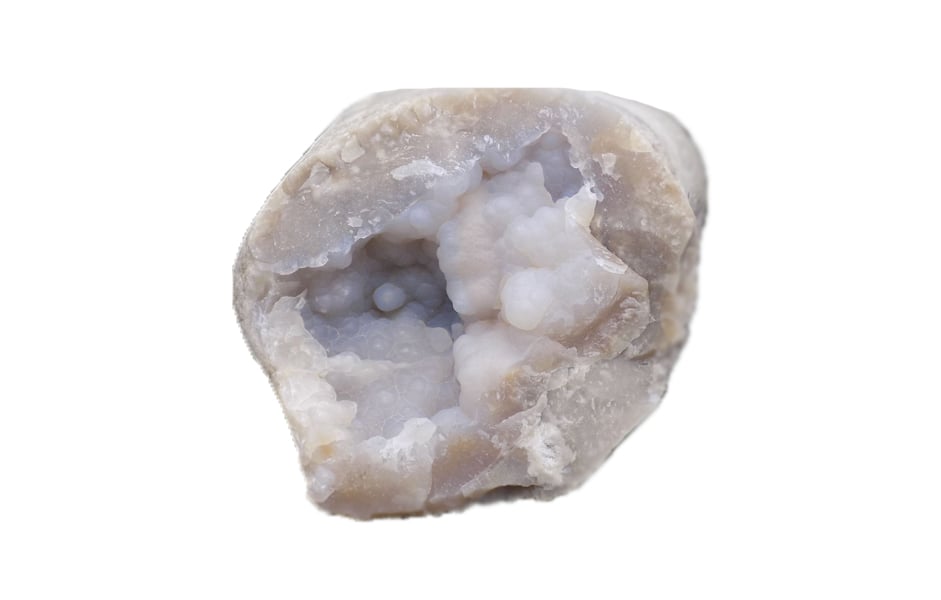
Characteristics: Chalcedony is a type of quartz that is notable for its fine-grained texture. Some well-known varieties of chalcedony include agate, carnelian and onyx. Widely used in jewelry and ornamental carvings, chalcedony is valued for its durability, unique waxy luster and diverse color palette. It is also believed by some to possess metaphysical properties, including promoting calmness and enhancing communication.
Colors: This type of quartz comes in a plethora of shades. Milky or translucent white, gray, light blue and pink, purple, yellow, brown, green or orange, as well as vibrant red tones.
Mohs Hardness Score: 6.5 – 7
Magnesite
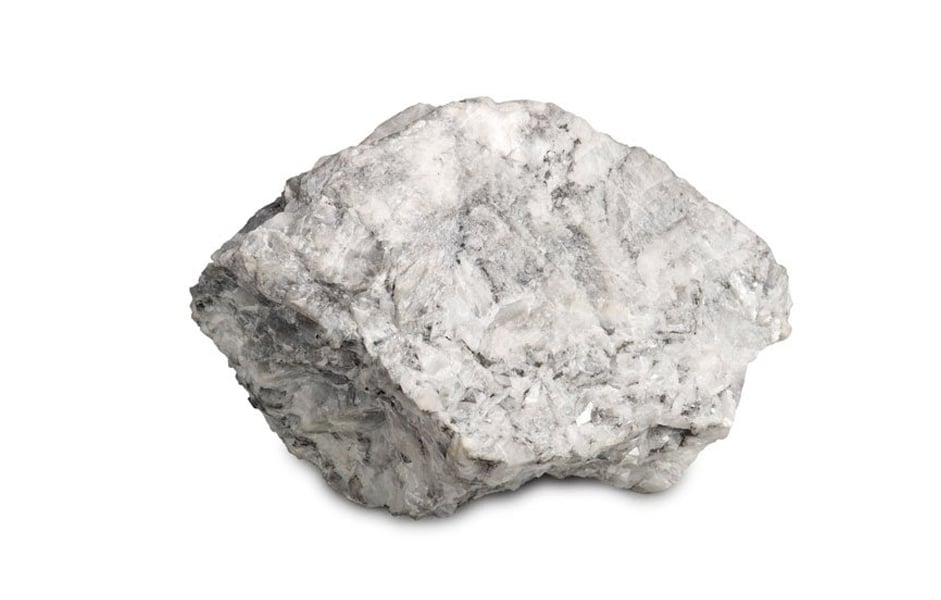
Characteristics: Magnesite typically forms in magnesium-rich environments and it displays a vitreous to pearly luster. Magnesite has practical rather than aesthetic applications, as it is an important source of magnesium and as a refractory material in the production of magnesium oxide. Well-formed transparent crystals are rare – these are the ones usually used in jewelry.
Colors: Typically white or colorless, with seldom shades of gray, brown, green, or yellow due to the presence of impurities.
Mohs Hardness Score: 3.5 – 4.5
Ulexite

Characteristics: Ulexite is a borate mineral that is commonly known by the trade name ‘TV rock’ due to its unique optical properties. Ulexite is typically found in evaporite deposits as a result of the evaporation of water from alkaline lake environments. It presents a fibrous crystal structure, which allows it to transmit light along its fibers. This property creates a mesmerizing optical effect known as ‘fiber optic’ or ‘TV rock’ effect. When a piece of ulexite is placed on top of a written or printed text, the text appears to be projected through the mineral, creating a unique visual phenomenon.
Colors: Ulexite appears white or colorless, but it possesses unique optical properties that give it the ability to feature other hues other hues and patterns depending on the background or surface it is placed over.
Mohs Hardness Score: 2.5
Aragonite
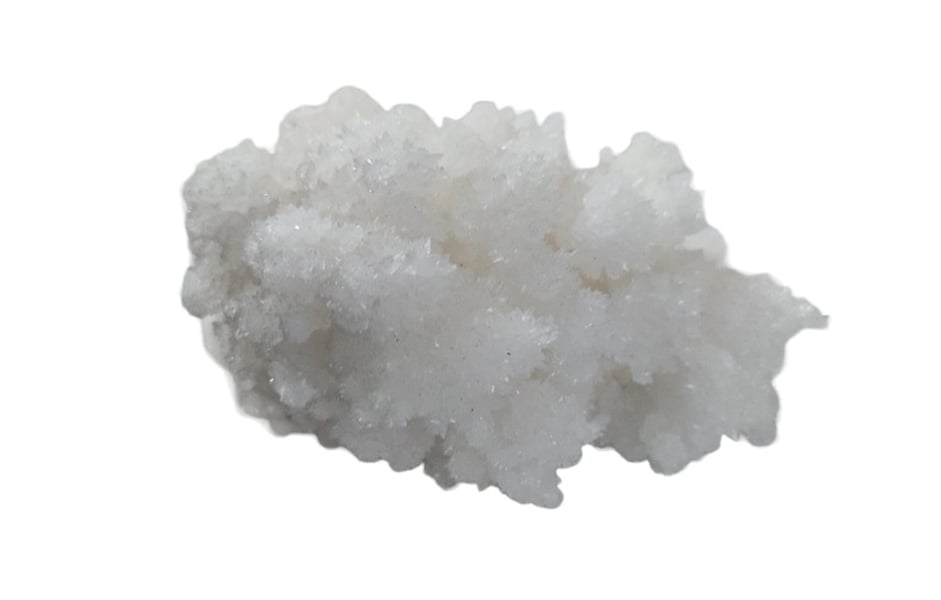
Characteristics: Aragonite is a carbonate mineral that presents needle-like crystals, stalactites – or it can be found as part of larger mineral formations. Aragonite is found in the shells of some marine organisms, such as corals and some types of mollusks, contributing to the formation of structures like coral reefs. It is used as a material for jewelry and decorative items when it forms in appealing crystal habits. Additionally, aragonite has applications in various industrial processes, including the production of cement and as a soil conditioner in agriculture.
Colors: Occurs in a range of colors, including white gemstones, gray, red, orange, green and blue.
Mohs Hardness Score: 3.5 – 4
Mother of Pearl
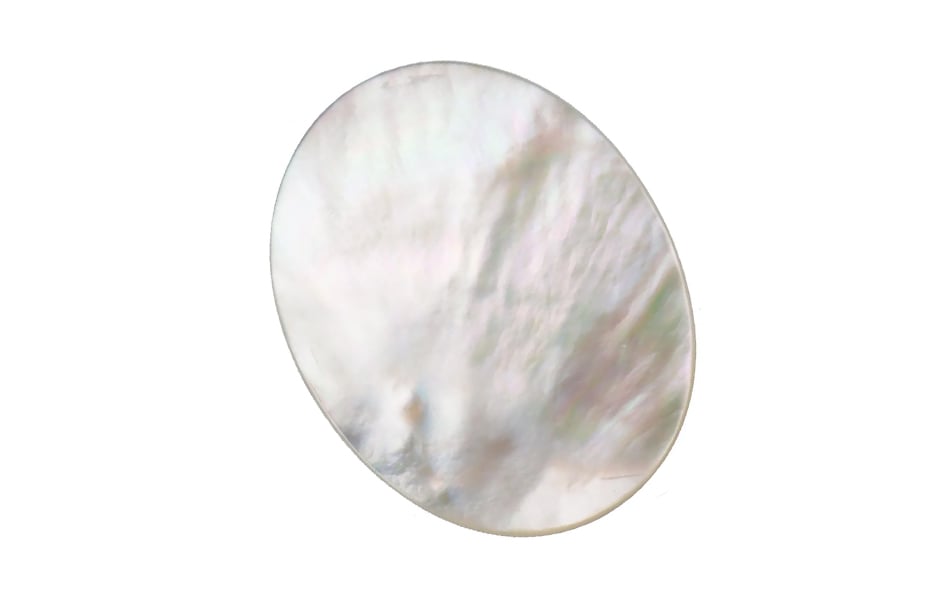
Characteristics: Mother of pearl, also called ‘nacre’, is an iridescent biomineral comprising of tightly packed layers and produced by mollusks. It is known for its striking visual effects, featuring a shimmery spectrum of colors that result from light interference and refraction. The material’s lustrous appearance and unique play of colors make it highly valued for ornamental and decorative purposes, including mother of pearl jewelry and inlay work.
Colors: White, iridescent blue-green, purple, silver and grey, golden and beige or black.
Mohs Hardness Score: 2.5 – 4.5
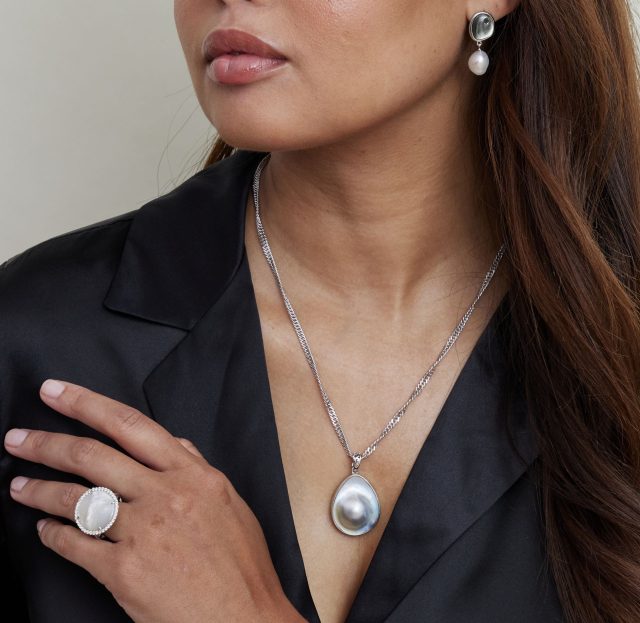
GEM SPOTLIGHT
Mother of Pearl is radiant, iridescent and mesmerizing from every angle. Discover our Mother of Pearl collection, featuring jewelry pieces in modern designs, including various types of earrings, pendants and statement rings that add that timeless charm and captivating glow to any jewelry collection.
Kyanite
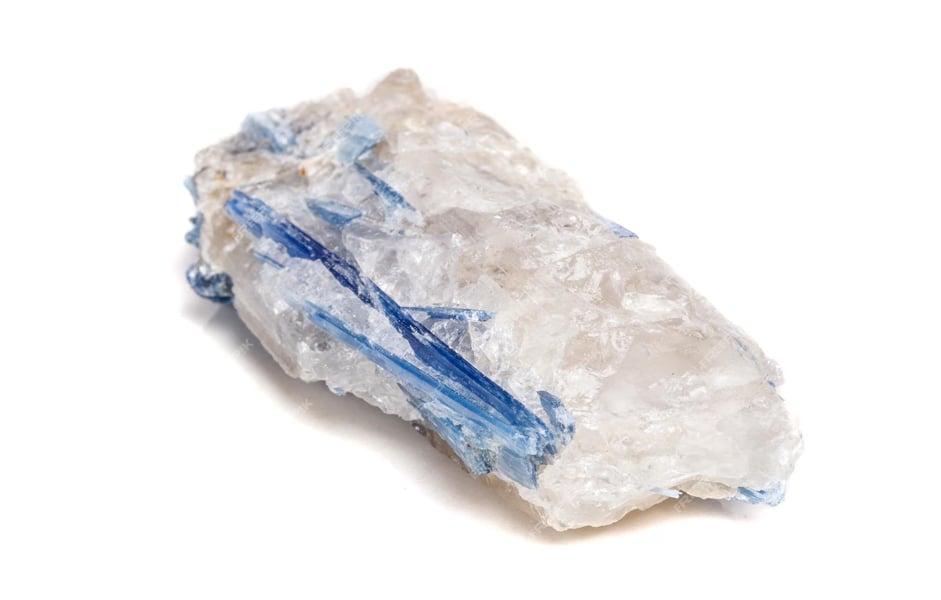
Characteristics: Kyanite is a silicate mineral that presents bladed crystal formations. Its color variations are due to trace elements. The material is used in the production of ceramics, refractory materials, and as a gemstone. Renowned for its transparency, hardness, and unique crystal structure, kyanite’s diverse qualities contribute to its significance in various fields, from manufacturing to ornamental and metaphysical uses.
Colors: White, green, blue and gray tones.
Mohs Hardness Score: 4.5 – 7
Marble Stone

Characteristics: Marble is a metamorphic rock primarily that includes calcite or dolomite crystals. It is valued for its distinctive veined or mottled pattern and utilized extensively in sculpture, architecture, and ornamental applications. Compared to granite, this white stone is softer stone and perfectly white when 100% pure in composition. It presents a highly smooth texture, translucency and a high polish.
Colors: White, gray, beige, cream, as well as several vivid tones, all a result of chemical impurities.
Mohs Hardness Score: 2 – 3
Dolomite
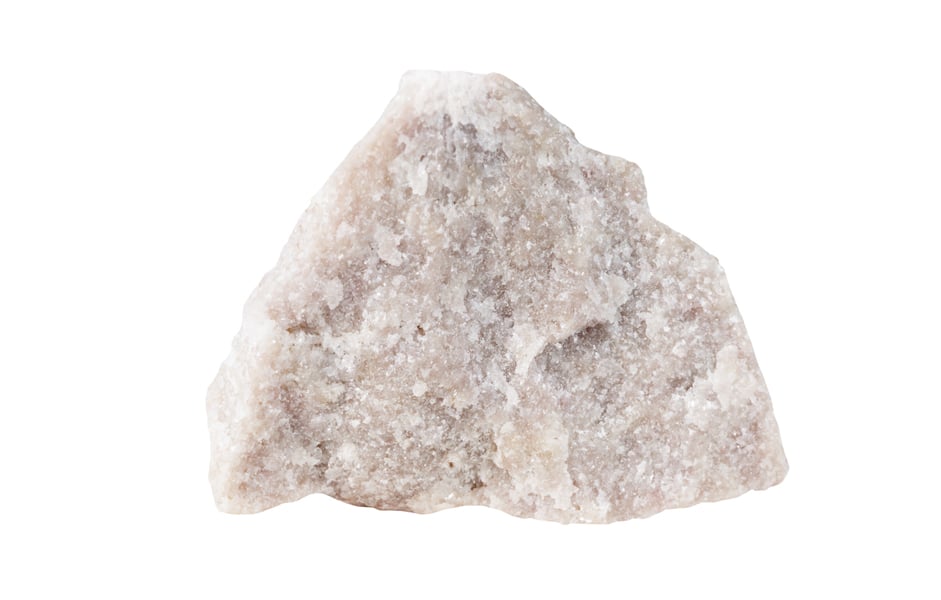
Characteristics: Dolomite is a carbonate mineral composed of calcium magnesium carbonate with a translucent to transparent appearance and a vitreous to pearly luster. Frequently found in sedimentary environments, it plays a role in the formation of rocks such as dolostone. Dolomite’s versatility extends to decorative applications, construction, and as a source of magnesium.
Colors: Ranging from white to gray, pink and shades of green, all as a result of impurities.
Mohs Hardness Score: 3.5 – 4
Jasper
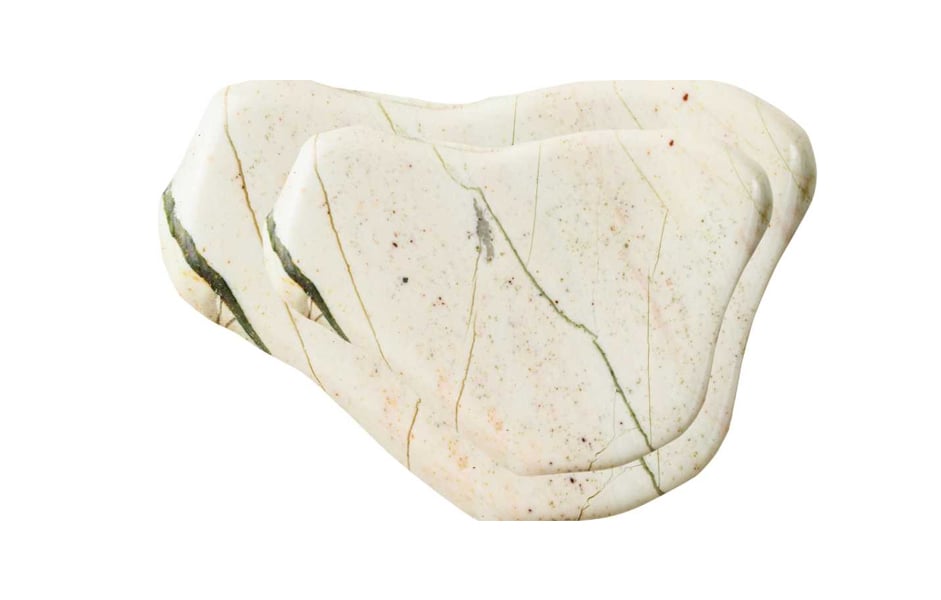
Characteristics: Jasper is an opaque and microcrystalline form of quartz. Its colors come from various mineral impurities, and it often displays unique patterns, such as stripes or spots, as well as a high polish surface. Jasper is valued for its earthy tones and patterns, making it a popular choice in jewelry, carving, and decorative objects like vases and boxes.
Colors: Jasper presents a diverse spectrum of colors, including red, brown, yellow, green, and more.
Mohs Hardness Score: 6.5 – 7
Grossular Garnet
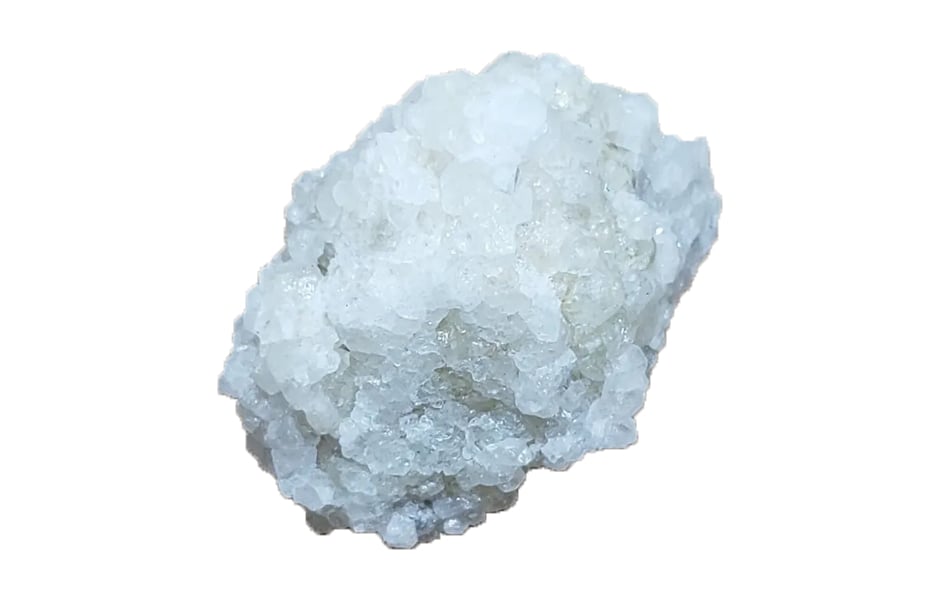
Characteristics: Grossular garnet is a calcium-aluminum garnet species. Varieties such as tsavorite, a green grossular, are highly valued on the market. Grossular garnet’s transparency and brilliance make it desirable for gemstones. It may also display asterism, a phenomenon that produces a star-like pattern when cut in cabochons. Found in diverse geological settings, grossular garnet’s versatility contributes to its use in jewelry and as a collector’s gem. Its name is derived from the Latin ‘grossularia’ meaning gooseberry, due to the green variety’s similarity to the fruit.
Colors: A varied range, including white gemstones, brown, orange, green and yellow. The color spectrum results from different metal ions and trace elements.
Mohs Hardness Score: 6.5 – 7.5
Jade
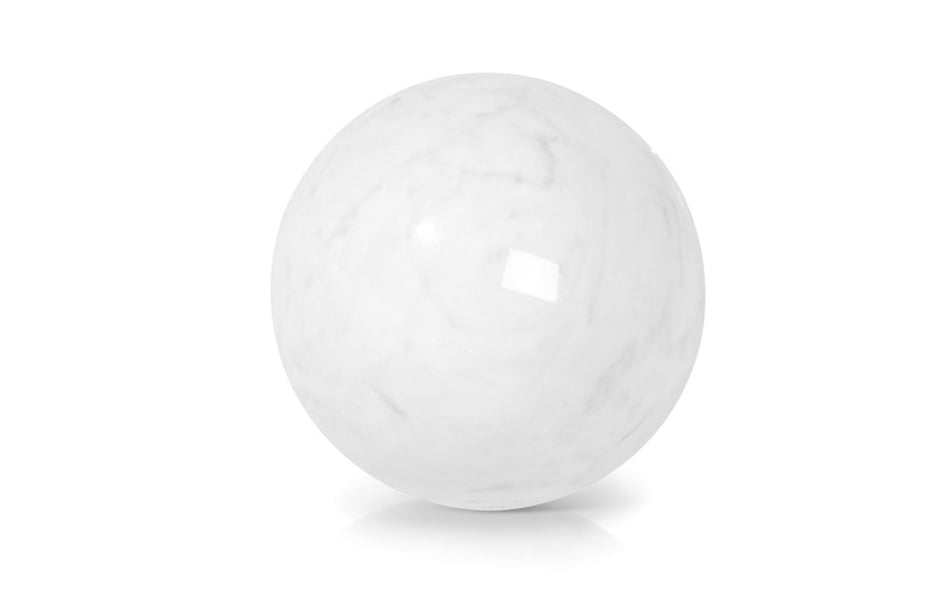
Characteristics: Jade refers to two mineral species: jadeite and nephrite. The gemstones are highly valued in jewelry, especially the traditional green ones. Jade is durable, lustrous and often used in ornaments, weapons and small sculptures. Jade boasts a deep-rooted connection with China, where its mining and craftsmanship date back to the Stone Age.
Colors: Jade typically appears in shades of green, white, brown, or black, lavender, yellow, and more.
Mohs Hardness Score: 6 – 7
Howlite
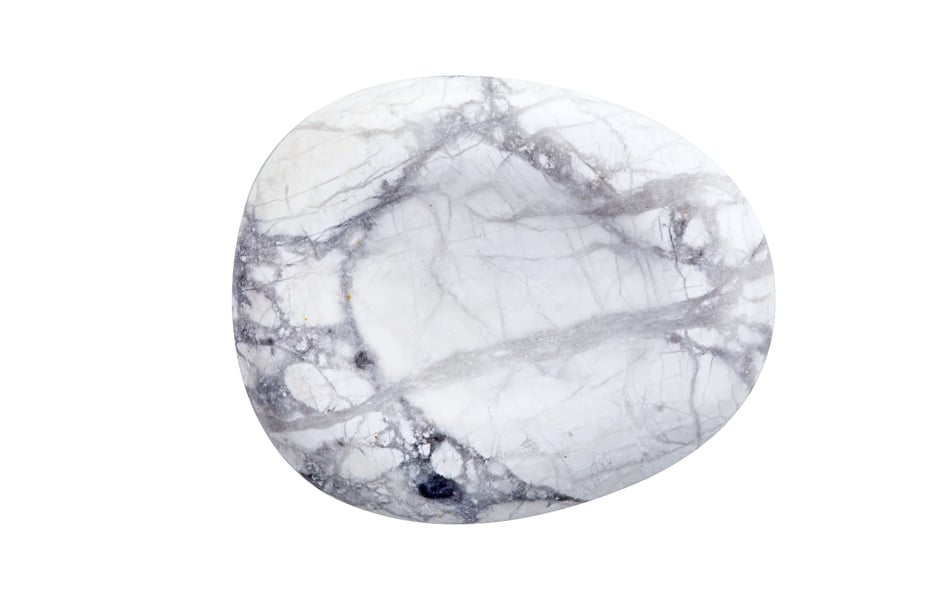
Characteristics: Howlite is a borate mineral that is often used as a substitute for other white stones, such as turquoise. Howlite’s porous nature makes it suitable for dyeing, and it is commonly found in shades of blue, green, or other colors. Its smooth texture and distinctive veining patterns contribute to its popularity in jewelry, beads, and carvings. While naturally white or gray, howlite’s versatility in appearance allows for creative use in various decorative applications.
Colors: It typically appears in white to light gray colors with characteristic gray to black veining, resembling a marble-like pattern.
Mohs Hardness Score: 3.5
Aventurine
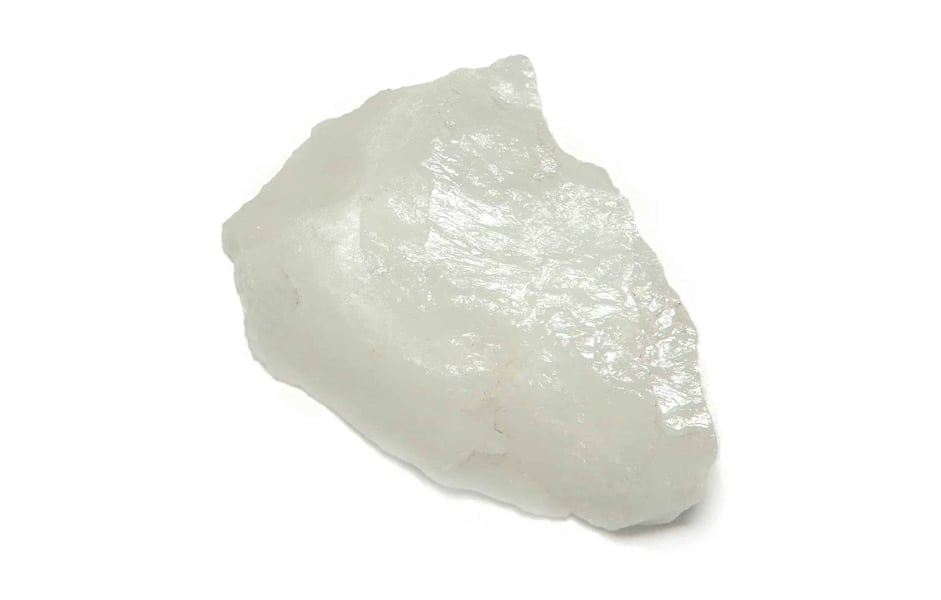
Characteristics: Aventurine is a variety of quartz known for its sparkling appearance, caused by the presence of mica or other mineral inclusions. The glittering effect, called aventurescence, results from the reflections of these mineral inclusions. Aventurine’s translucency and captivating sheen make it popular in jewelry and ornamental carvings. This gemstone is valued for its positive energy associations and it is believed to bring luck and prosperity.
Colors: The most common color is green, but it can also occur in shades of white, blue, brown, peach, yellow, and red.
Mohs Hardness Score: 6.5 – 7
Coral

Characteristics: Coral is an organic gemstone formed from the skeletons of marine polyps. The primary factors influencing color are the species of coral and environmental conditions during growth. Coral is prized for its vibrant hues and unique branching or irregular surface textures. Commonly used in jewelry, especially in beaded or carved forms, coral has cultural and historical significance and is often associated with protective and healing properties in various traditions. Sustainable harvesting practices are crucial due to environmental concerns.
Colors: Coral’s shades range from white and pink to red, with some specimens exhibiting shades of orange, blue, and black.
Mohs Hardness Score: 3 – 4
Buffalo Turquoise
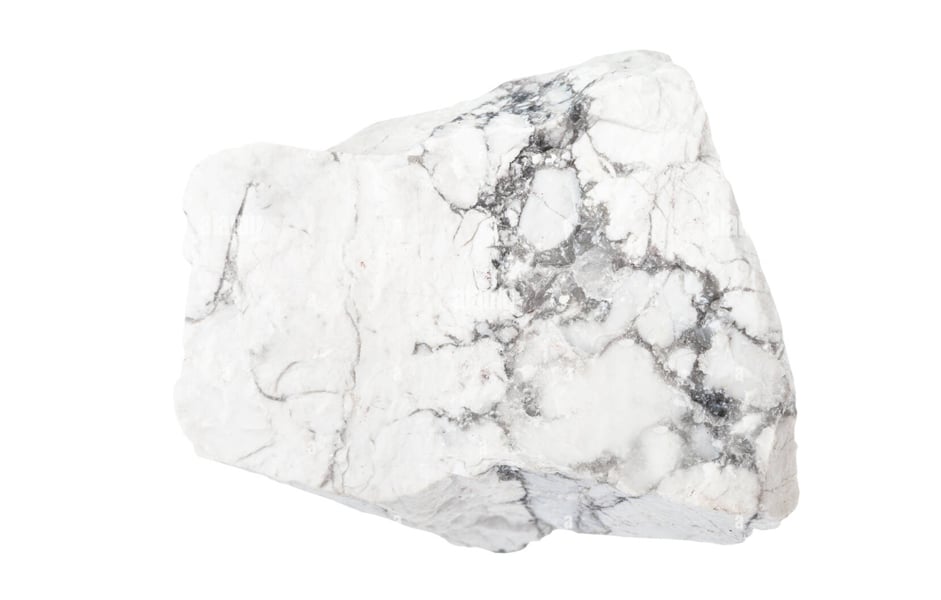
Characteristics: Buffalo Turquoise is not a natural type of turquoise, although it is named as such and is strikingly similar, except lighter and desaturated. Buffalo turquoise or white buffalo stone is a calcite mineral that is similar to dolomite, typically used in bohemian jewelry as a white gemstone. It forms near turquoise under similar environmental conditions. The trade name represents stones that originate in Nevada.
Colors: White with dark patterns in black, gray or brown.
Mohs Hardness Score: 5 – 6
Moss in Snow Jade
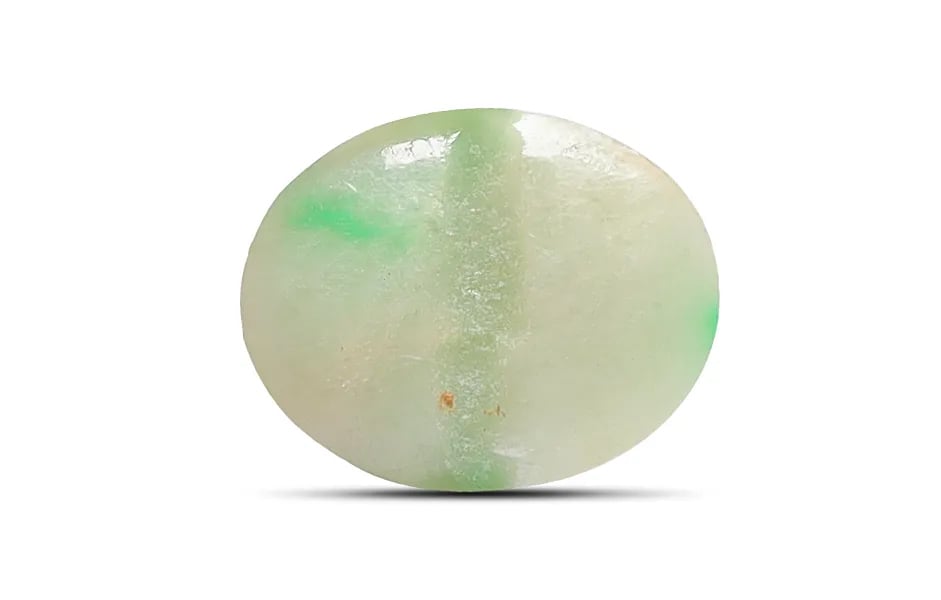
Characteristics: Moss in snow jade is a rare gemstone that is commonly referred to as ‘moss agate’, as well as ‘mossy jade’. It is a type of jade that presents a unique play of colors: moss-like inclusions in green within a white or colorless base, giving the impression of greenery peeking through snow. Due to this quality, the material is used in jewelry and ornamental carvings. It’s made up of two minerals: actinolite and quartz and it’s found mainly in regions with high altitudes and low temperatures, such as the Himalayas.
Colors: White base with green patterns in shades of light green, olive, or lime green.
Mohs Hardness Score: 6.5 – 7
Andalusite
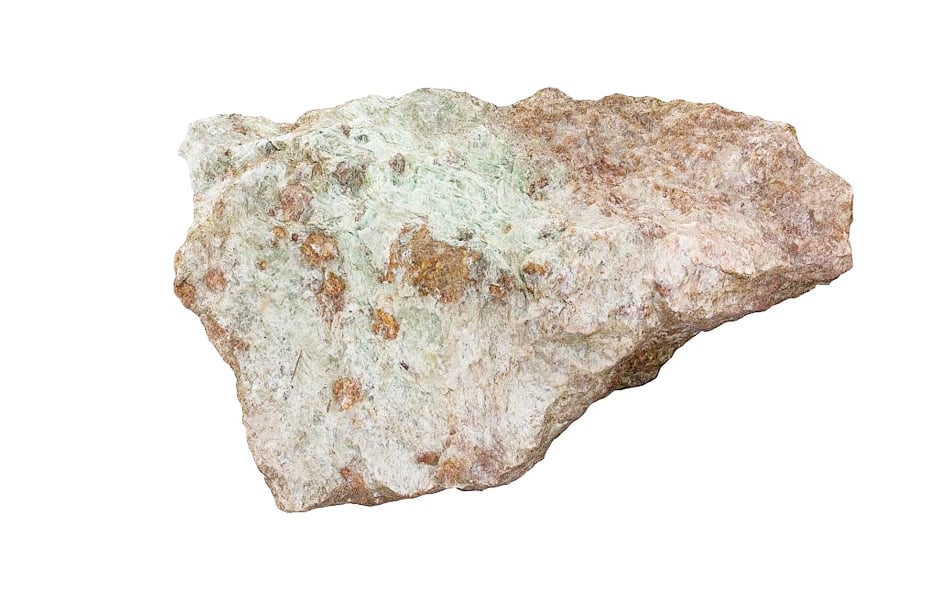
Characteristics: Andalusite is a type of aluminum silicate mineral. It has a pleochroic nature, meaning different colors come through from different crystal orientations. It features high transparency and a vitreous to sub-vitreous luster. Widely used in jewelry, as well as various industries, due to the fact that it presents a high melting point and thermal stability.
Colors: Green, white, brown and reddish-brown.
Mohs Hardness Score: 7 – 7.5
Prehnite
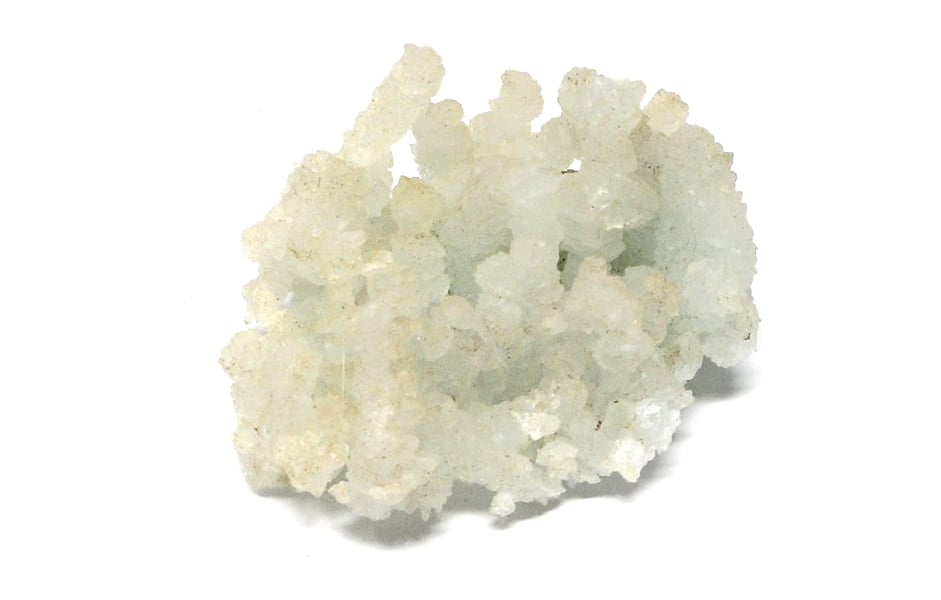
Characteristics: Prehnite is found in crystalline formations and it features a typically vitreous to pearly luster. Its color variations come from iron or manganese impurities. Due to its transparent or translucent qualities as well as relative durability, this white crystal presents a unique play of light, which is why it is often utilized in jewelry, as well as ornamental carvings.
Colors: Colorless, white, pale green to yellow-green, gray and brown.
Mohs Hardness Score: 6 – 6.5
Celestite
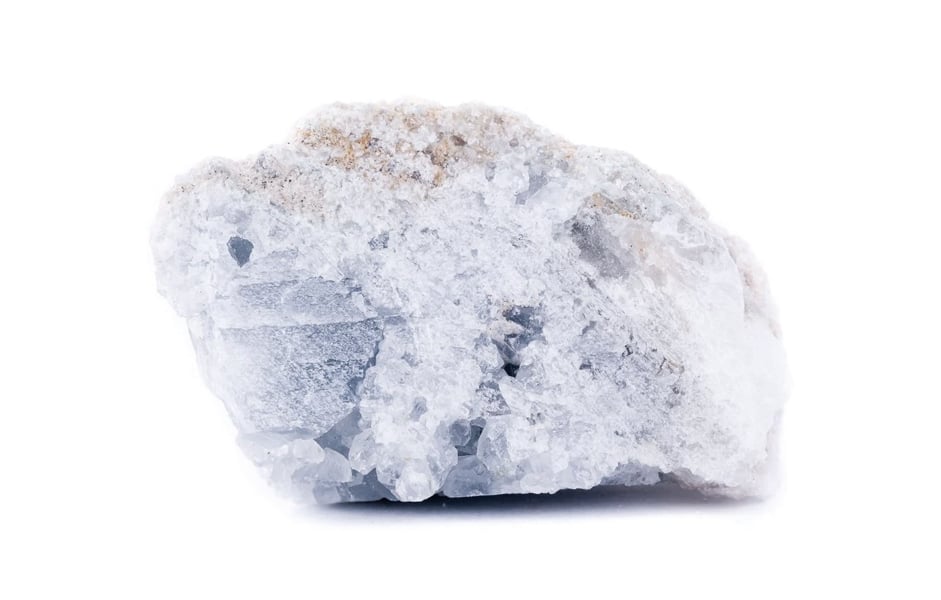
Characteristics: Celestite is a mineral that forms in in well-defined crystals, featuring a prismatic or tabular structure. It is transparent to translucent, allowing light to create an appealing play of colors. It is valued for its uniquely ethereal appearance, predominant in crystal healing practices, as well as in the glass, ceramics and nuclear energy industries.
Colors: Celestite is mostly valued and recognized for its blue hues, which vary from sky blue to deep shades. It often presents with a white colored base.
Mohs Hardness Score: 3 – 3.5
Calcite
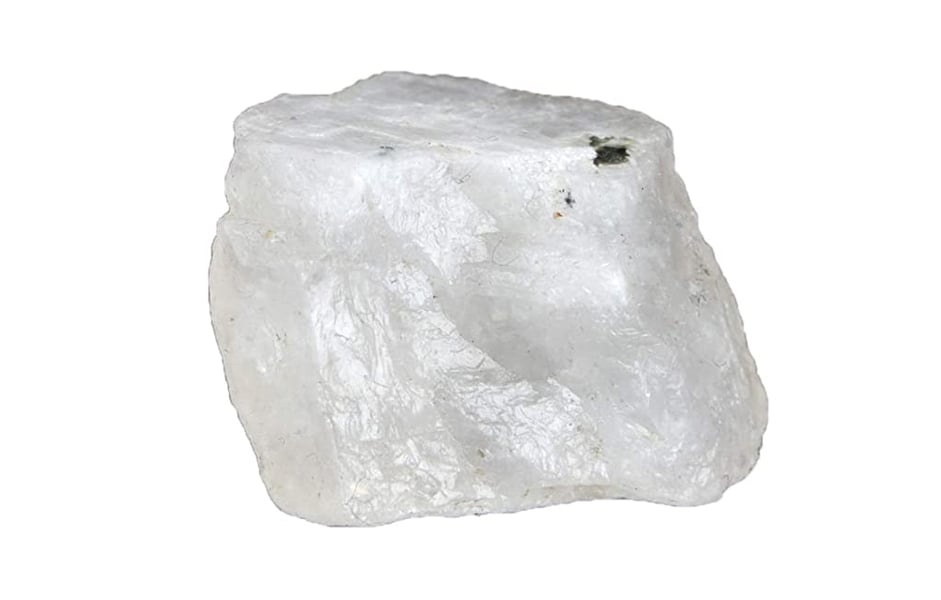
Characteristics: Calcite is a type of carbonate mineral that appears in a crystal form. It is transparent to translucent, with a typical vitreous or pearly luster. These white crystals are utilized in various industrial applications, including in construction, agriculture and the pharmaceutical industry. Calcite is one of the most abundant minerals in the world. Various sea organisms including corals and algae make their shells out of calcite, by pulling carbon dioxide from the sea water.
Colors: A wide array, including colorless and white (most predominant), green, pink, blue, orange or yellow.
Mohs Hardness Score: 3
Apatite
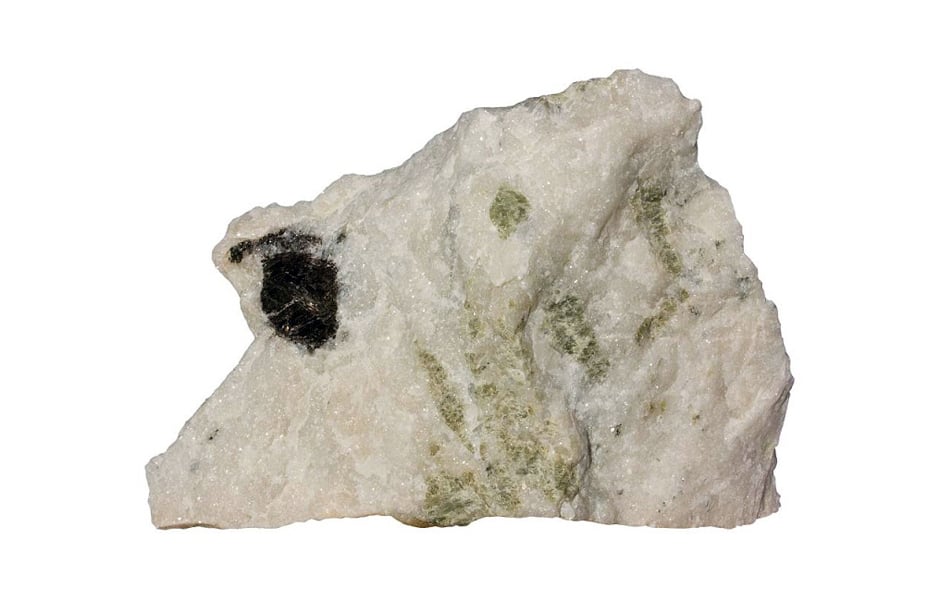
Characteristics: Apatite is a type of phosphate mineral with a crystalline structure. It often presents as fluorescent under ultraviolet light. The word ‘apatite’ comes from the Greek word ‘apatein’, which actually means ‘to deceive’. This is because the mineral is often confused with other gemstones, including topaz, aquamarine and tourmaline.
Colors: Transparent, white gemstones, blue, green and yellow gems are common. It contains hydroxyl, fluorine, or chlorine, which contribute to its color variations. Blue apatite is the most prized for its uses in jewelry.
Mohs Hardness Score: 5
Alabaster
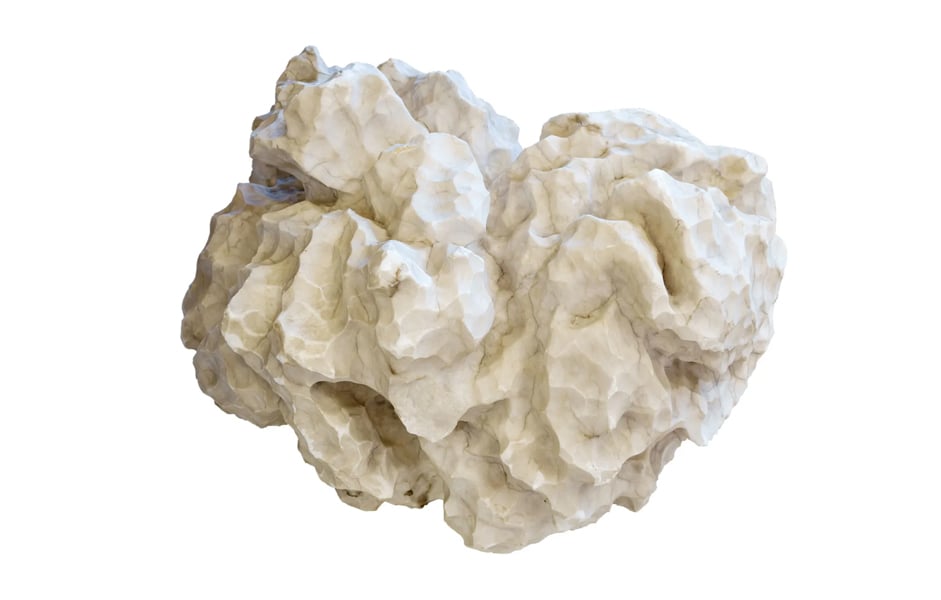
Characteristics: Alabaster is a type of gypsum that is notable for its soft and translucent appearance in various light colors. This white stone features a smooth and milky texture and it is valued for its tactile qualities, which makes it a highly popular material in sculptures and decorative art, as well as in lighting. Immersed in water at high temperatures, alabaster can resemble marble and become opaque.
Colors: White, pale pink, cream, beige and light shades of gray.
Mohs Hardness Score: 1.5
Final Thoughts
With their immaculate appeal, purity and shimmering qualities, white gemstones, white crystals and white stones make irresistible fashion accessories. Used for millennia in crystal healing, and believed to carry numerous beneficial properties, as well as in a variety of industries, desaturated gemstones certainly serve more than a decorative function.
From lush, crisp-white pearls to mesmerizing moonstone and fuzzy okenite, there’s a lot of beauty, mystery and charm in all white gemstones. Which one is your personal favorite gem? Let us know in the comment section below!
For similar content, make sure to check our comprehensive guides on Pink Gemstones and Black Gemstones!
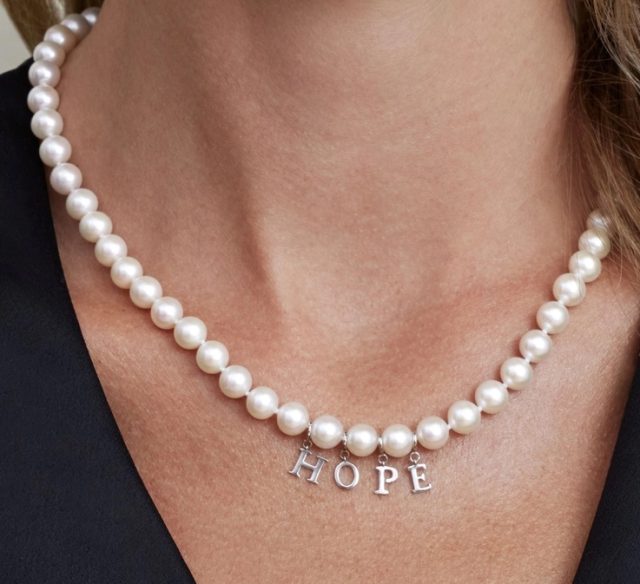
JEWELRY SPOTLIGHT
Classic elegance never goes out of style. They’re chic, they’re lustrous and they carry the magic of the ocean. The epitome of white gemstones, aka the classic white pearl is the must-have piece in every jewelry collection. Discover our collection featuring a wide range of classic and modern types of necklaces, adorned with premium freshwater and saltwater pearls.
- Your Ultimate Guide on the Coquette Aesthetic - April 8, 2024
- Strings Attached: Justin Timberlake Goes Pearlcore on SNL - January 31, 2024
- 39 Types of White Gemstones: Properties, Uses and Benefits - November 22, 2023

